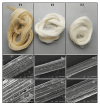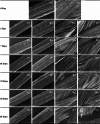Natural cellulose fibers derived from Dracaena angolensis (Welw. ex Carrière) Byng & Christenh. demonstrate potential as a non-absorbable surgical suture biomaterial
- PMID: 39779811
- PMCID: PMC11711317
- DOI: 10.1038/s41598-025-85886-3
Natural cellulose fibers derived from Dracaena angolensis (Welw. ex Carrière) Byng & Christenh. demonstrate potential as a non-absorbable surgical suture biomaterial
Abstract
Sutures from natural and synthetic materials are utilized to close wounds, stop bleeding, reduce pain and infection, repair cutaneous wounds, minimize scarring, and promote optimal wound healing. We used mechanical and chemical methods to extract cellulose fibers from cylindrical snake grass (Dracaena angolensis) (Welw. ex Carrière) Byng & Christenh. Following the extraction process, the fibers increased in cellulose and water content, while hemicellulose and lignin decreased. The extracted fibers exhibited good mechanical properties, with weight losses of 7.4% in deionized water (DI) and 13.7% in phosphate-buffered saline (PBS). In comparison, the commercial braided silk sutures (Mersilk braided silk non-absorbable suture) used as a control showed no weight loss. However, the morphology of the fibers remained consistent throughout the 35-day immersion period in either DI or PBS. In an in vivo biocompatibility test, a semi-quantitative analysis of host tissue reactions indicated no significant difference (p > 0.05) between the two suturing materials across all criteria, confirming the comparable biocompatibility of cylindrical snake grass fibers to that of commercial silk sutures. These findings demonstrate the promising potential of natural cellulose fibers derived from cylindrical snake grass as an alternative source of a non-absorbable surgical suture biomaterial, attributed to their outstanding mechanical properties and biocompatibility.
Keywords: Dracaena angolensis (Welw. ex Carrière) Byng & Christenh; Cellulose; Cylindrical snake grass; Natural fibers; Non-absorbable suture material.
© 2025. The Author(s).
Conflict of interest statement
Declarations. Competing interests: The authors declare no competing interests.
Figures








Similar articles
-
[Mechanical Testing of Tendons Sutured with Newly Developed Biomaterial].Acta Chir Orthop Traumatol Cech. 2020;87(3):210-214. Acta Chir Orthop Traumatol Cech. 2020. PMID: 32773023 Czech.
-
Fiber from ramie plant (Boehmeria nivea): A novel suture biomaterial.Mater Sci Eng C Mater Biol Appl. 2016 May;62:816-22. doi: 10.1016/j.msec.2016.02.040. Epub 2016 Feb 16. Mater Sci Eng C Mater Biol Appl. 2016. PMID: 26952488
-
Natural Cellulose Fibers for Surgical Suture Applications.Polymers (Basel). 2020 Dec 18;12(12):3042. doi: 10.3390/polym12123042. Polymers (Basel). 2020. PMID: 33353190 Free PMC article.
-
Properties, Production, and Recycling of Regenerated Cellulose Fibers: Special Medical Applications.J Funct Biomater. 2024 Nov 16;15(11):348. doi: 10.3390/jfb15110348. J Funct Biomater. 2024. PMID: 39590552 Free PMC article. Review.
-
Impact of intra-abdominal absorbable sutures on surgical site infection in gastrointestinal and hepato-biliary-pancreatic surgery: results of a multicenter, randomized, prospective, phase II clinical trial.Surg Today. 2017 Sep;47(9):1060-1071. doi: 10.1007/s00595-017-1480-3. Epub 2017 Feb 23. Surg Today. 2017. PMID: 28233105 Review.
References
-
- Dennis, C. et al. Suture materials - current and emerging trends. J. Biomed. Mater. Res. A. 104, 1544–1559 (2016). - PubMed
-
- Lou, C. W. et al. Manufacturing and properties of PLA Absorbable Surgical suture. Text. Res. J.78, 958–965 (2008).
-
- Niculescu, M. et al. Evaluation of biodegradability of surgical synthetic absorbable suture materials: an in vitro study. Mat. Plast.53, 642–645 (2016).
-
- Sreenivasan, V. S., Somasundaram, S., Ravindran, D., Manikandan, V. & Narayanasamy, R. Microstructural, physico-chemical and mechanical characterisation of Sansevieria cylindrica fibres – an exploratory investigation. Mater. Des.32, 453–461 (2011).
-
- Kandimalla, R. et al. Fiber from ramie plant (Boehmeria nivea): a novel suture biomaterial. Mater. Sci. Eng. C Mater. Biol. Appl.62, 816–822 (2016). - PubMed
MeSH terms
Substances
LinkOut - more resources
Full Text Sources

